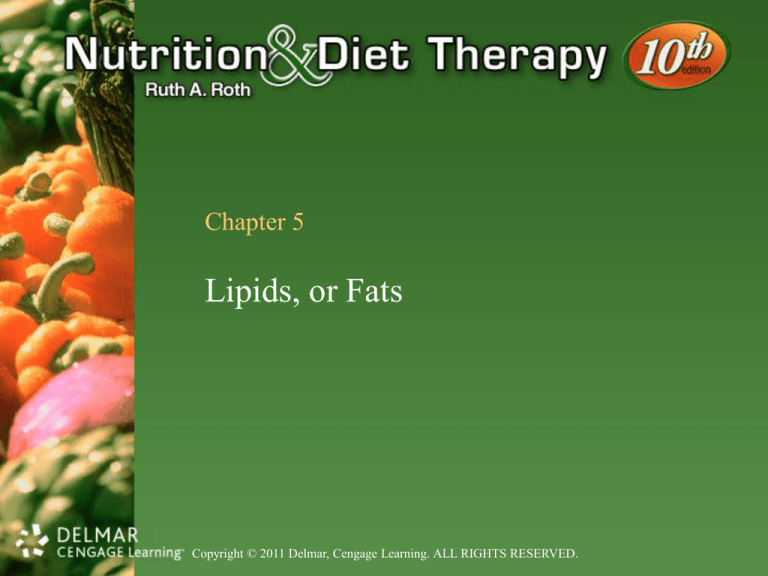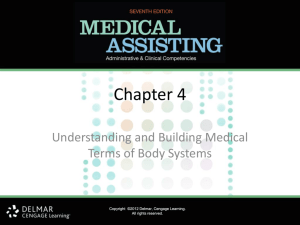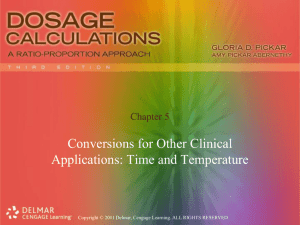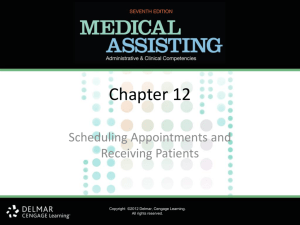
Chapter 5
Lipids, or Fats
Copyright © 2011 Delmar, Cengage Learning. ALL RIGHTS RESERVED.
Objectives
•
•
•
•
State functions of fats in body
Identify sources of dietary fats
Explain common classifications of fats
Describe disease conditions with which
excessive use of fats are associated
Copyright © 2011 Delmar, Cengage Learning. ALL RIGHTS RESERVED.
Facts
• Fats
– Belong to group of organic compounds
• Lipids
– Greasy substances
– Insoluble in water
• Each gram of fat contains 9 calories
• Composed of carbon, hydrogen, and oxygen
– Lower proportion of oxygen than carbohydrates
Copyright © 2011 Delmar, Cengage Learning. ALL RIGHTS RESERVED.
Functions
•
•
•
•
•
•
Provide energy
Carry fat-soluble vitamins
Supply essential fatty acids
Protect and support organs and bones
Insulate from cold
Provide satiety after meals
Copyright © 2011 Delmar, Cengage Learning. ALL RIGHTS RESERVED.
Food Sources
• Animal
– Fatty meats and fish
– Dairy products
– Egg yolks
(continues)
Copyright © 2011 Delmar, Cengage Learning. ALL RIGHTS RESERVED.
Food Sources
• Plant
–
–
–
–
–
Cooking oils and margarine
Nuts
Avocados
Coconut
Cocoa butter
Copyright © 2011 Delmar, Cengage Learning. ALL RIGHTS RESERVED.
Visible and Invisible Fats
• Visible
• Invisible
– Fats in foods that are
purchased and used as fats
– E.g., butter, margarine,
lard, cooking oils
– Fats not immediately
noticeable
– E.g., egg yolks, cheese,
cream, salad dressings
Copyright © 2011 Delmar, Cengage Learning. ALL RIGHTS RESERVED.
Stop and Share
• Consider the following scenario:
– You are the nurse teaching a class about nutrition. A client
asks about ways to decrease the amount of fat in his diet.
What are some suggestions you can offer him?
(continues)
Copyright © 2011 Delmar, Cengage Learning. ALL RIGHTS RESERVED.
Stop and Share
• Beware of hidden fats
• Decrease amount of fatty meats
– E.g., bacon, sausage, luncheon meats
– Use lean meats, instead
• Use low-fat or skim milk
• Use egg whites instead of yolks when possible
– Egg white contains no fat
• Almost entirely protein and water
Copyright © 2011 Delmar, Cengage Learning. ALL RIGHTS RESERVED.
Classification
• Triglycerides
– Most lipids in body
• 95 percent
– Composed of three fatty acids attached to framework of
glycerol
• Phospholipids
• Sterols
– Cholesterol
Copyright © 2011 Delmar, Cengage Learning. ALL RIGHTS RESERVED.
Fatty Acid Classification
• May be classified by body’s need for them:
– Essential fatty acids (EFAs)
– Nonessential
(continues)
Copyright © 2011 Delmar, Cengage Learning. ALL RIGHTS RESERVED.
Fatty Acid Classification
• May be classified by degree of saturation with
hydrogen atoms:
– Saturated
– Unsaturated
• Monounsaturated
• Polyunsaturated
Copyright © 2011 Delmar, Cengage Learning. ALL RIGHTS RESERVED.
Essential Fatty Acids
• Cannot be synthesized by body
• Must be obtained from diet
• Two families:
– Omega-3
– Omega-6
Copyright © 2011 Delmar, Cengage Learning. ALL RIGHTS RESERVED.
Nonessential Fatty Acids
• Can be synthesized by body
• Omega-9 fatty acids can be synthesized in
body when EFAs present
– Previously thought to be essential
Copyright © 2011 Delmar, Cengage Learning. ALL RIGHTS RESERVED.
Saturated Fats
• Each of its carbon atoms carries all hydrogen
atoms possible
• In general, animal foods contain more saturated
fatty acids than unsaturated
• Usually solid at room temperature
(continues)
Copyright © 2011 Delmar, Cengage Learning. ALL RIGHTS RESERVED.
Saturated Fats
• E.g., meat, poultry, egg yolks, whole milk,
whole milk cheeses, cream, ice cream, butter,
chocolate, coconut, palm oil
Copyright © 2011 Delmar, Cengage Learning. ALL RIGHTS RESERVED.
Monounsaturated Fats
• Have one place among carbon atoms where
there are fewer hydrogen atoms attached than
in saturated fats
• Lower low-density lipoprotein (LDL or “bad”
cholesterol) when they replace saturated fat in
one’s diet
(continues)
Copyright © 2011 Delmar, Cengage Learning. ALL RIGHTS RESERVED.
Monounsaturated Fats
• E.g., olive oil, canola oil, avocados, cashew
nuts
• Recommend 15 percent of total daily calories
Copyright © 2011 Delmar, Cengage Learning. ALL RIGHTS RESERVED.
Polyunsaturated Fats
• Have two or more places among carbon atoms
where there are fewer hydrogen atoms attached
than in saturated fats
• E.g., cooking oils made from sunflower,
safflower, sesame seeds, corn, or soybeans;
soft margarines with liquid vegetable oil as
major ingredient; fish
(continues)
Copyright © 2011 Delmar, Cengage Learning. ALL RIGHTS RESERVED.
Polyunsaturated Fats
• Foods containing high proportions of
polyunsaturated fats
– Usually soft or oily
• Omega-3
– Lower risk of heart disease
(continues)
Copyright © 2011 Delmar, Cengage Learning. ALL RIGHTS RESERVED.
Polyunsaturated Fats
• Omega-6
– Lower cholesterol
• Recommend 8 percent or less of total daily
calories
Copyright © 2011 Delmar, Cengage Learning. ALL RIGHTS RESERVED.
Trans Fatty Acids (TFAs)
• Produced when hydrogen atoms added to
monounsaturated or polyunsaturated fats to
produce semi-solid product
– E.g., margarine, shortening
• Raise LDL and total cholesterol
(continues)
Copyright © 2011 Delmar, Cengage Learning. ALL RIGHTS RESERVED.
TFAs
• Major sources:
– Baked goods
– Restaurant foods
Copyright © 2011 Delmar, Cengage Learning. ALL RIGHTS RESERVED.
Hydrogenated Fats
• Polyunsaturated vegetable oils to which
hydrogen has been added commercially to
make them solid at room temperature
• Hydrogenation
– Process that turns polyunsaturated vegetable oils into
saturated fats
– E.g., margarine, shortening
Copyright © 2011 Delmar, Cengage Learning. ALL RIGHTS RESERVED.
Cholesterol
• Sterol
– Fatlike substance
• Exists in animal foods and body cells
• Does not exist in plant foods
(continues)
Copyright © 2011 Delmar, Cengage Learning. ALL RIGHTS RESERVED.
Cholesterol
• Essential for synthesis of bile, sex hormones,
cortisone, and vitamin D
• Needed by every cell in body, but
manufactured by liver
Copyright © 2011 Delmar, Cengage Learning. ALL RIGHTS RESERVED.
Stop and Share
• Consider the following scenario:
– Your client has been diagnosed with a high cholesterol
level greater than 200 mg per dL. Answer the following
questions:
• What risks are associated with a high cholesterol level?
• What can be done to lower a high cholesterol level?
(continues)
Copyright © 2011 Delmar, Cengage Learning. ALL RIGHTS RESERVED.
Stop and Share
• High cholesterol leads to atherosclerosis
– Cardiovascular disease in which plaque forms on inside of
artery walls
• Plaque
– Fatty deposits containing cholesterol and other substances
– Can lead to heart attacks and strokes
(continues)
Copyright © 2011 Delmar, Cengage Learning. ALL RIGHTS RESERVED.
Stop and Share
• Reduce amount of total fat, saturated fats, and
cholesterol
• Increase monounsaturated fats, lose weight,
and exercise
• Increase consumption of soluble dietary fiber
(continues)
Copyright © 2011 Delmar, Cengage Learning. ALL RIGHTS RESERVED.
Stop and Share
• Do not exceed daily cholesterol intake of
300 mg
• In some cases, have medication prescribed
Copyright © 2011 Delmar, Cengage Learning. ALL RIGHTS RESERVED.
Digestion and Absorption
• 95 percent of ingested fats digested
• Chemical digestion of fats occurs mainly in
small intestine
• No digestion of fats occurs in mouth
• Slight digestion in stomach where gastric
lipase acts on emulsified fats
(continues)
Copyright © 2011 Delmar, Cengage Learning. ALL RIGHTS RESERVED.
Digestion and Absorption
• Digestion in small intestine
– Bile emulsifies fats
– Lipase reduces fats to fatty acids and glycerol
– Absorption occurs through villi of small intestine
Copyright © 2011 Delmar, Cengage Learning. ALL RIGHTS RESERVED.
Lipoproteins
• Bile joins with products of fat digestion to
carry fat
• Protein combines with final products of fat
digestion to form lipoproteins
• Lipoproteins carry fat in blood to body cells
(continues)
Copyright © 2011 Delmar, Cengage Learning. ALL RIGHTS RESERVED.
Lipoproteins
• Classified according to mobility and density
• Types:
–
–
–
–
Chylomicrons
Very-low-density lipoproteins (VLDLs)
LDLs
High-density lipoproteins (HDLs)
Copyright © 2011 Delmar, Cengage Learning. ALL RIGHTS RESERVED.
Chylomicron
• First lipoprotein identified after eating
• Largest lipoprotein
– Yet lightest in weight
• Composed of 80 to 90 percent triglycerides
Copyright © 2011 Delmar, Cengage Learning. ALL RIGHTS RESERVED.
VLDLs
• Made by liver to transport lipids throughout
body
• Composed of 55 to 65 percent triglycerides
• Carry triglycerides and other lipids to all cells
• As VLDL lose triglycerides, pick up
cholesterol from other lipoproteins in blood
– Become LDL
Copyright © 2011 Delmar, Cengage Learning. ALL RIGHTS RESERVED.
LDLs
• Composed of 45 percent cholesterol with few
triglycerides
• Carry most of blood cholesterol from liver to
cells
• Level greater than 130 mg per dL
– Considered to contribute to atherosclerosis
• “Bad” cholesterol
Copyright © 2011 Delmar, Cengage Learning. ALL RIGHTS RESERVED.
HDLs
• Carry cholesterol from cells to liver for
eventual excretion
• Level of 60 mg per dL or more
– Considered to reduce risk of heart disease
(continues)
Copyright © 2011 Delmar, Cengage Learning. ALL RIGHTS RESERVED.
HDLs
• Increase by doing the following:
– Exercising
– Maintaining desirable weight
– Giving up smoking
• “Good” cholesterol
Copyright © 2011 Delmar, Cengage Learning. ALL RIGHTS RESERVED.
Metabolism and Elimination
• Liver controls fat metabolism
• In cells, fatty acids broken down to carbon
dioxide and water
– Releasing energy
(continues)
Copyright © 2011 Delmar, Cengage Learning. ALL RIGHTS RESERVED.
Metabolism and Elimination
• Excess fat stored as adipose tissue
• Carbon dioxide and water removed from body
by circulatory, respiratory, and excretory
systems
Copyright © 2011 Delmar, Cengage Learning. ALL RIGHTS RESERVED.
Stop and Share
• Consider the following scenario:
– Your client asks you about a new dietary supplement that
advertisers claim provides essential nutrients and lowers
cholesterol “naturally.” How do you advise your client?
(continues)
Copyright © 2011 Delmar, Cengage Learning. ALL RIGHTS RESERVED.
Stop and Share
• Any new dietary supplement with nutritional
claim should be evaluated carefully
• If item not included in Recommended Daily
Allowance (RDA) or DRI, assume medical
research has not determined it essential
• Ingestion of dietary supplements of unknown
value could be damaging to one’s health
Copyright © 2011 Delmar, Cengage Learning. ALL RIGHTS RESERVED.
Phospholipid
• Found in both plant and animal foods
• Synthesized in liver
• Natural emulsifier that helps transport fat in
bloodstream
• E.g., lecithin
Copyright © 2011 Delmar, Cengage Learning. ALL RIGHTS RESERVED.
Fat Alternatives
• Olestra
– Made from carbohydrates and fat
– FDA approved for use in snack food
– Food labels must indicate that it “inhibits absorption of
some vitamins and other nutrients”
– Should be used in moderation
– Contains no calories
– Can cause cramps and diarrhea
(continues)
Copyright © 2011 Delmar, Cengage Learning. ALL RIGHTS RESERVED.
Fat Alternatives
• Simplesse
– Made from egg white or milk protein
– Can be used only in cold foods
– Not available for home use
(continues)
Copyright © 2011 Delmar, Cengage Learning. ALL RIGHTS RESERVED.
Fat Alternatives
• Oatrim
– Carbohydrate-based
• Derived from oat fiber
– Can be used in baking
• But not frying
– Provides calories
• But less than fat
Copyright © 2011 Delmar, Cengage Learning. ALL RIGHTS RESERVED.
Dietary Requirements
• Deficiency symptoms occur when fats provide
less than 10 percent of total daily calories
• Food and Nutrition Board’s Committee on
Diet and Health recommends that people
reduce fat intake to 30 percent of total calories
(continues)
Copyright © 2011 Delmar, Cengage Learning. ALL RIGHTS RESERVED.
Dietary Requirements
• American Heart Association’s newest
recommendation:
– Consume ≤ 7 percent of saturated fats, 8 percent
polyunsaturated fats, and 15 percent monounsaturated fats
• At present, 36 percent of calories in U.S. diets
derived from fats
Copyright © 2011 Delmar, Cengage Learning. ALL RIGHTS RESERVED.
Conclusion
• Fats provide energy, carry essential fatty acids
and fat-soluble vitamins, protect organs and
bones, insulate from cold, and provide satiety
after meals
• Fats are composed of carbon, hydrogen, and
oxygen
– Found in both animal and plant foods
(continues)
Copyright © 2011 Delmar, Cengage Learning. ALL RIGHTS RESERVED.
Conclusion
• Each gram of fat provides 9 calories
• Digestion occurs primarily in small intestines
• Excess of fat in diet can result in obesity, heart
disease, or cancer
Copyright © 2011 Delmar, Cengage Learning. ALL RIGHTS RESERVED.








